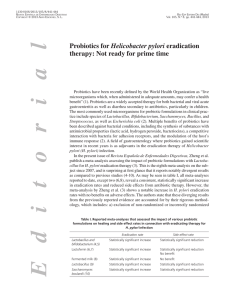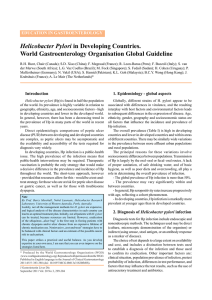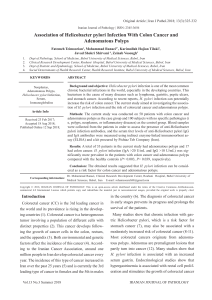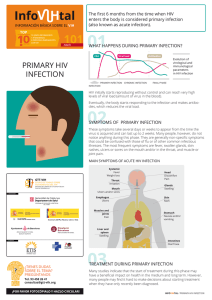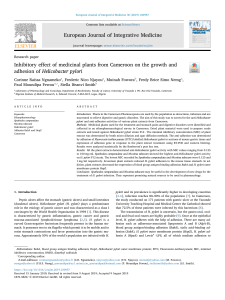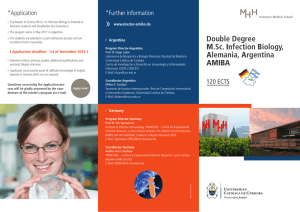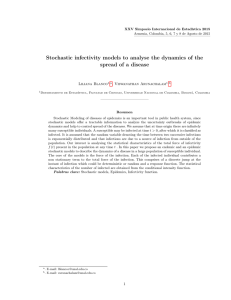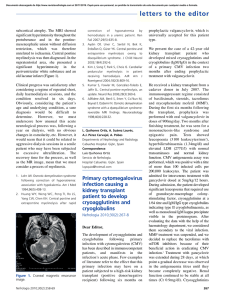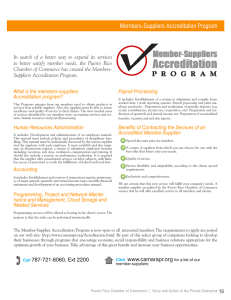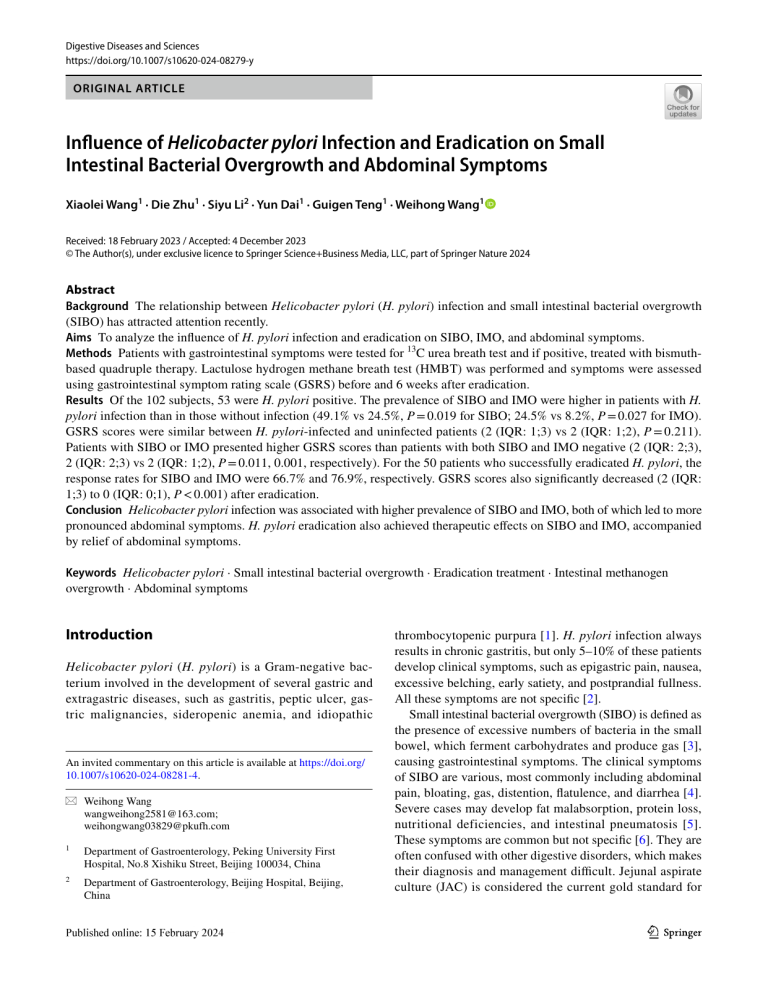
Digestive Diseases and Sciences https://doi.org/10.1007/s10620-024-08279-y ORIGINAL ARTICLE Influence of Helicobacter pylori Infection and Eradication on Small Intestinal Bacterial Overgrowth and Abdominal Symptoms Xiaolei Wang1 · Die Zhu1 · Siyu Li2 · Yun Dai1 · Guigen Teng1 · Weihong Wang1 Received: 18 February 2023 / Accepted: 4 December 2023 © The Author(s), under exclusive licence to Springer Science+Business Media, LLC, part of Springer Nature 2024 Abstract Background The relationship between Helicobacter pylori (H. pylori) infection and small intestinal bacterial overgrowth (SIBO) has attracted attention recently. Aims To analyze the influence of H. pylori infection and eradication on SIBO, IMO, and abdominal symptoms. Methods Patients with gastrointestinal symptoms were tested for 13C urea breath test and if positive, treated with bismuthbased quadruple therapy. Lactulose hydrogen methane breath test (HMBT) was performed and symptoms were assessed using gastrointestinal symptom rating scale (GSRS) before and 6 weeks after eradication. Results Of the 102 subjects, 53 were H. pylori positive. The prevalence of SIBO and IMO were higher in patients with H. pylori infection than in those without infection (49.1% vs 24.5%, P = 0.019 for SIBO; 24.5% vs 8.2%, P = 0.027 for IMO). GSRS scores were similar between H. pylori-infected and uninfected patients (2 (IQR: 1;3) vs 2 (IQR: 1;2), P = 0.211). Patients with SIBO or IMO presented higher GSRS scores than patients with both SIBO and IMO negative (2 (IQR: 2;3), 2 (IQR: 2;3) vs 2 (IQR: 1;2), P = 0.011, 0.001, respectively). For the 50 patients who successfully eradicated H. pylori, the response rates for SIBO and IMO were 66.7% and 76.9%, respectively. GSRS scores also significantly decreased (2 (IQR: 1;3) to 0 (IQR: 0;1), P < 0.001) after eradication. Conclusion Helicobacter pylori infection was associated with higher prevalence of SIBO and IMO, both of which led to more pronounced abdominal symptoms. H. pylori eradication also achieved therapeutic effects on SIBO and IMO, accompanied by relief of abdominal symptoms. Keywords Helicobacter pylori · Small intestinal bacterial overgrowth · Eradication treatment · Intestinal methanogen overgrowth · Abdominal symptoms Introduction Helicobacter pylori (H. pylori) is a Gram-negative bacterium involved in the development of several gastric and extragastric diseases, such as gastritis, peptic ulcer, gastric malignancies, sideropenic anemia, and idiopathic An invited commentary on this article is available at https://doi.org/ 10.1007/s10620-024-08281-4. * Weihong Wang [email protected]; [email protected] 1 Department of Gastroenterology, Peking University First Hospital, No.8 Xishiku Street, Beijing 100034, China 2 Department of Gastroenterology, Beijing Hospital, Beijing, China thrombocytopenic purpura [1]. H. pylori infection always results in chronic gastritis, but only 5–10% of these patients develop clinical symptoms, such as epigastric pain, nausea, excessive belching, early satiety, and postprandial fullness. All these symptoms are not specific [2]. Small intestinal bacterial overgrowth (SIBO) is defined as the presence of excessive numbers of bacteria in the small bowel, which ferment carbohydrates and produce gas [3], causing gastrointestinal symptoms. The clinical symptoms of SIBO are various, most commonly including abdominal pain, bloating, gas, distention, flatulence, and diarrhea [4]. Severe cases may develop fat malabsorption, protein loss, nutritional deficiencies, and intestinal pneumatosis [5]. These symptoms are common but not specific [6]. They are often confused with other digestive disorders, which makes their diagnosis and management difficult. Jejunal aspirate culture (JAC) is considered the current gold standard for Vol.:(0123456789) Digestive Diseases and Sciences diagnosing SIBO [7]. However, it is invasive, time-consuming, costly, and has a high risk of contamination [8], which limits its application. Breath test is a cheap, simple, and safe auxiliary diagnostic method for SIBO. Therefore, glucose and lactulose hydrogen/methane breath tests (HMBT) are recommended as the noninvasive alternatives to assess conditions with bloating and the presence of antibiotic-responsive microbial colonization of the gastrointestinal tract by the North American Consensus group [7]. For lactulose HMBT, an increase in hydrogen concentrations of 20 ppm or more from baseline within 90 min after taking lactulose is the diagnostic basis for SIBO. While according to the ACG clinical guideline for SIBO [4], a methane concentration of ≥ 10 ppm at any point during the test indicates the colonization of methanogenic archaea in the small intestine or colon, which is defined as intestinal methanogen overgrowth (IMO). As both H. pylori infection and SIBO can cause abdominal discomfort, with some degree of overlap in symptoms, the relationship between the two conditions has attracted attention in recent years. Enko et al. [9] found that the incidence of SIBO in individuals with active H. pylori infection was twice as high as that of uninfected individuals, indicating that H. pylori infection might be a risk factor for SIBO. Another study [10] reported a greater methane production in H. pylori-infected patients than in uninfected individuals during lactulose HMBT. Nevertheless, there were also studies with contrary results [11]. All the above studies were retrospective and failed to include adequate controls to exclude confounding factors associated with SIBO, which influenced the reliability of the conclusions. Therefore, it is necessary to conduct novel studies to further investigate the relationship between H. pylori infection and SIBO and their respective contributions to clinical symptoms. Bismuth-based quadruple therapy (proton pump inhibitor (PPI), bismuth, and two antibiotics) was recommended for H. pylori treatment by the Chinese consensus report on the management of H. pylori infection [12]. The recommended antibiotics include amoxicillin, clarithromycin, metronidazole, levofloxacin, tetracycline, and furazolidone [12]. Among which amoxicillin, metronidazole, and levofloxacin are also commonly used to treat SIBO [4]. On the other hand, PPI administration was reported to be associated with an increased risk of SIBO. A large meta-analysis [13] including over 7000 participants revealed a statistically significant increase in the risk of SIBO in PPI users. Therefore, we speculate that certain H. pylori treatment regimens may also have some impact on SIBO, although the degree and direction are unclear. In this study, we first assessed the association between H. pylori infection and the prevalence of SIBO and their influence on abdominal symptoms. Then, we treated H. pylori-infected patients with amoxicillin-metronidazole quadruple therapy to explore the influence of eradication therapy on SIBO and abdominal symptoms. Materials and Methods Patients and Observation Indicators Patients who underwent 13C urea breath test (13C-UBT) for gastrointestinal symptoms at the Department of Gastroenterology of Peking University First Hospital from September to December 2021 were invited to evaluate their suitability for participation in the study. Subjects were included if their ages were ranged from 18 to 70 years and had no history of previous H. pylori eradication. The following patients were excluded from the study through medical history inquiry or by reviewing endoscopic findings, imaging data, and laboratory results within 12 months: (1) Patients with erosive esophagitis, active peptic ulcer, or upper gastrointestinal malignancy; (2) Patients who met Rome IV symptom criteria for irritable bowel syndrome at enrollment; (3) Patients with clinical status associated with SIBO: previous gastrointestinal surgery, inflammatory bowel disease, liver cirrhosis, chronic pancreatitis, celiac disease, systemic sclerosis, diabetes, metabolic syndrome, immune disorders, and vital organ insufficiency; (4) Patients with medication history that may have impact on SIBO: exposed to antibiotics/probiotics within 6 months or any PPI or histamine 2 receptor antagonist intake within 3 months; continuously used PPI for more than 2 weeks in the 12 months prior to enrollment; (5) 13 C-UBT-positive patients who were allergic to treatment drugs; and (6) Pregnant and lactating women. According to the inclusion and exclusion criteria, patients were consecutively included in this study. Lactulose HMBT was performed within one week after 13C-UBT. Demographic data, previous medical history, allergy history, medication history, and gastroscopic results were collected at enrollment. Abdominal symptoms were assessed using the Gastrointestinal Symptom Rating Scale (GSRS) which has a 0–3 scale with 0 representing no symptoms and 3 representing very severe or troublesome symptoms. Patients with H. pylori infection were treated with bismuth quadruple therapy containing amoxicillin and metronidazole. 13 C-UBT and HMBT were repeated at 6 weeks after the end of the therapy. Adverse reactions, compliance, and improvement of symptoms were recorded simultaneously. Ethical approval for this study was obtained from the Ethics Committee of Peking University First Hospital (Scientific Research No. 2021-324). Written informed consent was obtained from all patients. Digestive Diseases and Sciences Sample Size Calculation Statistical Analysis The sample size was calculated using PASS 2008 (NCSS, Kaysville, UT, USA). According to previous literature reports [9, 10], the detection rates of SIBO in H. pyloriinfected and uninfected patients were approximately 50% and 20%, respectively. Setting the alpha error probability to 0.05 and the statistical power to 0.85, 43 patients were required in each group. Considering a 10% dropout rate, a total of 96 patients were needed, with 48 in each group. Data were statistically analyzed using SPSS software V.26.0 (SPSS, Inc., Chicago, IL). Quantitative data of normal distribution were expressed as mean ± standard deviation, and Student’s t test or McNemer’s test was used for comparisons between groups. Quantitative data that did not conform to a normal distribution were expressed as median and interquartile range (IQR), and the Mann–Whitney U test or Wilcoxon’s signed rank test was used. Paired t tests were used for pairwise comparisons between the pre- and post-treatment data. Qualitative data were expressed as the number of cases and percentages and compared using the χ2 or Fisher’s exact test. Statistical tests were 2-sided, and P values less than 0.05 were considered statistically significant. 13 C‑UBT 13 C-UBT was performed after an 8–12-h fasting period. Patients should avoid smoking or exerting physical effort. Breath samples were obtained before and 30 min after the ingestion of a capsule containing 75 mg 13C-labeled urea. A HeliFANplus FANci3 device set (Fischer Analysen Instrumente GmbH, Leipzig, Germany) was used to obtain the DOB value. A sample was considered positive if DOB was above 4‰, which indicated active H. pylori infection. Lactulose HMBT All enrolled patients underwent lactulose HMBT using a Nanocoulomb breath analyzer CA4458 (Wuxi Sunvou Medical Electronics Co., Ltd., Wuxi, China). Patients were required to fast for 8–12 h and avoided fermentable foods 24 h before the breath test. Exhaled air was sampled once in the fasting state and at time intervals of 30 min for up to 90 min following the intake of 10-g lactulose (Abbott Laboratories Ltd., Shanghai, China). Patients with an increase of ≥ 20 ppm in hydrogen concentration from baseline within 90 min were diagnosed with SIBO (SIBO+), while patients with methane concentration of ≥ 10 ppm at any point during the test were diagnosed with IMO (IMO+) [4]. Those who were positive or negative for both tests were recorded as SIBO+IMO+ or SIBOIMO-, respectively. Results Demographic Characteristics A total of 102 subjects including 49 males and 53 females were enrolled. The mean age of the participants was 42.1 ± 9.9 years. Among them, 53 were H. pylori positive and 49 were negative. The characteristics of the patients at enrollment is summarized in Table 1. No significant differences in age, gender, BMI, and smoking history were observed. Detection of SIBO and H. pylori Infection Of the 102 participants, 39 (38.2%) were SIBO+, 17 (16.7%) were IMO+, and 9 (8.8%) were SIBO+IMO+. The prevalence of SIBO was 49.1% (26/53) in H. pylori-infected patients and 26.5% (13/49) in H. pylori-uninfected patients, with statistical significance (P = 0.019). The prevalence of IMO in H. pylori-infected patients (13/53, 24.5%) was also significantly higher than that in uninfected patients (4/49, Table 1 Demographic data of the included patients Helicobacter pylori Treatment Patients who were diagnosed with H. pylori infection by positive 13C-UBT were treated with rabeprazole (Eisai Co. Ltd., Tokyo, Japan) 10 mg twice daily, amoxicillin (Kangenbei Pharmaceuticals Ltd, Jinhua, China) 1000 mg twice daily, and metronidazole (Yuanda Pharmaceuticals Ltd. Inc., Dalian, China) 400 mg three times daily, and bismuth potassium citrate (Livzon Pharmaceutical Group, Inc., Zhuhai, China) 220 mg twice daily for 14 days. Age (years), mean ± SD Gender, female% (n) BMI (kg/m2), median (interquartile range) Smoking history, % (n) H. pylori-uninfected patients (N = 49) H. pylori-infected P value patients (N = 53) 41.4 ± 10.8 42.8 ± 9.0 0.084 53.1 (26) 50.9 (27) 0.981 21.5 ± 3.9 22.0 ± 2.8 0.445 0 (0) 7.5 (4) 0.119 Digestive Diseases and Sciences 8.2%, P = 0.027). Seven H. pylori-infected patients and 2 uninfected patients were SIBO+IMO+. SIBO Was Associated with Abdominal Symptoms Figure 1 shows the distribution of GSRS scores in different types of patients. The GSRS scores for H. pylori-infected and uninfected patients were 2 (IQR: 1;3) and 2 (IQR: 1;2), respectively; and the score distribution was similar (P = 0.211) (Fig. 1a). The GSRS score in SIBO+ patients and IMO+ patients was both 2 (IQR: 2;3), which were significantly higher than SIBO-IMO- patients (GSRS score: 2, IQR: 1;2) (P = 0.011, 0.001, respectively) (Fig. 1b, c). In H. pylori-infected individuals, the GSRS score was (2, IQR: 2;3) for SIBO+ patients and (2, IQR: 1;2) for Fig. 1 The distribution of GSRS scores in different types of patients. (a H. pylori-infected vs. uninfected patients in all patients; b SIBO + patients vs. SIBO-IMO- patients in all patients; c IMO + patients vs. SIBO-IMO- patients in all patients; d H. pylori- SIBO-IMO- patients. The difference between their distributions failed to reach statistical significance (P = 0.102, Fig. 1d). While in H. pylori-infected IMO+ patients, the GSRS score was 2 (IQR: 2;3), which was significantly higher than that in SIBO-IMO- patients (P = 0.022, Fig. 1f). In H. pylori-uninfected individuals, the GSRS score was 2 (IQR: 2;2) for SIBO+ patients and 1.5 (IQR: 1;2) for SIBO-IMOpatients, without statistical significance (P = 0.086, Fig. 1e). Only 4 H. pylori-uninfected patients were IMO+, whose GSRS scores were 2, 2, 2, and 4, respectively. The sample size was too small to compare with SIBO-IMO- patients. The incidence of specific symptoms varied among different types of patients (Fig. 2). In H. pylori-infected individuals, the most frequently reported symptoms in SIBO+ patients were constipation (46.9%) and distention infected patients with SIBO + vs. SIBO-IMO-; e H. pylori-uninfected patients with SIBO + vs. SIBO-IMO-; f: H. pylori-infected patients with IMO + vs. SIBO-IMO-) Digestive Diseases and Sciences Fig. 2 The prevalence of abdominal symptoms according to the status of H. pylori infection, SIBO, and IMO (37.5%), followed by upper abdominal pain (34.4%). In IMO+ patients with H. pylori infection, the most frequent symptoms were constipation (76.9%), distention (38.5%) and poor appetite (30.8%). While in SIBO-IMO- patients, symptoms were upper abdominal pain (71.4%), poor appetite (52.4%), and distension (33.3%) in descending order. In H. pylori-uninfected individuals, the most common symptoms in SIBO+ patients were distention (100%), poor appetite (26.7%), and constipation (26.7%). In IMO+ patients not infected with H. pylori, the symptoms were ranked as distention (100%), constipation (50%), diarrhea (25%), and poor appetite (25%). In SIBO-IMO- patients, the common symptoms were poor appetite (38.2%), upper abdominal pain (35.3%), and distention (29.4%). Influence of H. pylori Eradication Therapy on SIBO A total of 53 H. pylori-infected patients received bismuthcontaining quadruple therapy with amoxicillin and metronidazole. Of these, 3 patients were lost to follow-up, with a loss rate of 2.9%. The intention-to-treat eradication rate was 94.3%, and the per-protocol eradication rate was 100%. Patients lost to follow-up were excluded from the subsequent analysis. The quadruple therapy used in our study significantly reduced the prevalence of SIBO. Twenty of the 30 SIBO+ patients responded to the treatment, with a remission rate of 66.7% (95% CI 48.8–84.6%). After eradication therapy, the prevalence of SIBO significantly decreased from 60 to 20% (P < 0.001) and had no statistical difference from that in H. pylori-uninfected patients (30.6%, P = 0.223). The trends were generally similar in IMO+ patients. The remission rate of IMO was 76.9% (95%CI 50.4–99.6%) after eradication. The prevalence of IMO decreased from 26.0 to 6.0% (P = 0.012) and had no statistical difference from that in H. pylori-uninfected patients (6.1%, P = 0.980) (Fig. 3). Influence of H. pylori Eradication Therapy on Abdominal Symptoms Abdominal symptoms were obviously resolved after eradication therapy. After treatment, the GSRS score of all H. pylori-infected patients decreased from 2 (IQR: 1;3) to 0 (IQR: 0;1) (Fig. S1a). The Wilcoxon’s signed rank test indicated a significant difference (P < 0.001). Of these, the median GSRS score decreased from 2 (IQR: 1.25;3) to 0 (IQR: 0;0) in SIBO+ patients (Fig. S1b), from 2 (IQR: 2;3) to 0 (IQR: 0;1) in IMO+ patients (Fig. S1c), and from 2 (IQR: 1;2) to 1 (IQR: 1;1) in SIBO-IMO- patients (Fig. S1d). The differences were all statistically significant (P < 0.001 for each). In H. pylori-infected SIBO+ patients, the GSRS score decreased by 2 (IQR: 1;2) after eradication, whereas in SIBO-IMO- patients, it decreased by 1 (IQR: 1;2). The difference between them did not reach statistical significance (P = 0.263). In H. pylori-infected IMO+ patients, the GSRS score decreased by 2 (IQR: 1.5;2.5), which was more significant than that in SIBO-IMO- patients (P = 0.048). After H. pylori eradication, when compared with SIBOIMO- patients, patients with SIBO+ had a more significant Digestive Diseases and Sciences Fig. 3 The effect of H. pylori eradication therapy on SIBO and IMO. *After eradication therapy, the prevalence of SIBO and IMO was significantly lower than that before treatment reduction in GSRS scores for abdominal pain; while in IMO+ patients, the reductions of scores for abdominal pain and constipation were both statistically significant (Table S1). After successful eradication of H. pylori, the GSRS score decreased by 1.5 (IQR: 1;2) in patients who remained SIBO+ and/or IMO+, whereas the GSRS score decreased by 2 (IQR: 1;2) in patients whose HMBT results switched to SIBO-IMO-. The difference was not statistically significant (P = 0.218). Discussion Limited research has investigated the relationship between H. pylori infection and SIBO. Two retrospective studies reported that H. pylori might be a risk factor for SIBO [9, 10]. However, the authors only considered the effects of PPIs, antibiotics, and other medication history on breath test, but did not exclude comorbidities that might have any influence on SIBO. In our study, we prospectively excluded the possible confounders and found that the prevalence of SIBO and IMO in H. pylori-infected patients was higher than that in uninfected patients. Patients with SIBO or IMO had higher GSRS scores than those with both SIBO and IMO negative and they had a different spectrum of symptoms. While GSRS scores and their distribution were similar between H. pylori-infected and uninfected patients. Six weeks after the eradication of H. pylori with bismuth quadruple therapy containing amoxicillin and metronidazole, the prevalence of SIBO and IMO, as well as the overall GSRS scores were significantly reduced. The possible mechanisms by which H. pylori infection promotes SIBO can be summarized as follows. Firstly, gastric acid plays an important role in preventing microbial overgrowth in the upper gastrointestinal tract [14]. H. pylori infection elevates the intragastric pH. Reduced gastric acid may allow oral flora and ingested food microorganisms to survive and colonize the small intestine. Influence of H. pylori infection on gastric acid secretion depends on the course of infection and the severity of gastritis. Acute infection with H. pylori directly interferes the transcription of HKα gene in the parietal cell, inhibiting the expression of the proton pump. H. pylori can also indirectly inhibit acid secretion by inducing the expression of cytokines, such as interleukin-1β. Chronic infection with H. pylori leads to the destruction of acid-secreting glands, Digestive Diseases and Sciences causing gastric mucosa atrophy, and intestinal metaplasia, and further aggravating hypochlorhydria [15]. In addition, H. pylori produces multimeric ureases that metabolize urea into ammonia and carbonic acid. These products in turn neutralize the gastric acidic environment [16], resulting in microbial overgrowth in the upper gastrointestinal tracts. Secondly, H. pylori reduces the secretion or activity of digestive enzymes and lowers gastrointestinal motility by interfering with the gastrointestinal neuroendocrine system [17]. Inadequate digestion increases the amount of carbohydrates remaining in the gastrointestinal tract, providing sufficient nutrients for bacteria. Thirdly, H. pylori may directly alter the gastrointestinal microbiota. It has been demonstrated that H. pylori infection affects the composition of the gastric microbiota by changing the gastric microenvironment [18]. Heimesaat et al. reported that long-term infection with H. pylori led to a distinct shift in microbiota composition in the distal GI tract [19]. Since commensal microbiota and the host are unique entities in a continuum along the gastrointestinal tract, every change in one of these players may modify the entire homeostasis. However, the exact mechanisms by which H. pylori infection promotes SIBO need to be further unraveled. To date, there is no well-established therapy for SIBO. Treatment with empiric antibiotics is common practice. Several antibiotics, including rifaximin, ciprofloxacin, metronidazole, doxycycline, and amoxicillin-clavulanate potassium, have been reported to be effective. Of these, rifaximin has accumulated the most supporting evidence. A meta-analysis including 7 randomized clinical trials, 24 cohort studies, and one randomized crossover study reported that the overall response rate of rifaximin for treating SIBO was 70.8% (95% CI 61.4–78.2%) [20]. For metronidazole, Lauritano et al. reported a response rate of 43.7% [21]. A crossover randomized trial observed a 50% response rate to amoxicillin-clavulanate potassium [22]. In 2018, Konrad et al. first attempted to treat H. pylori and SIBO simultaneously and achieved encouraging outcomes. They enrolled 30 H. pylori-infected patients with SIBO and treated them with pantoprazole, amoxicillin, and metronidazole for 10 days. Although this regimen achieved an underwhelming eradication rate of 63.3% for H. pylori infection, the response rate for SIBO was 60%, which was remarkable [23]. Currently, bismuth-based quadruple therapy containing amoxicillin and metronidazole is one of the first-line regimens for H. pylori eradication recommended by the Chinese consensus report for the management of Helicobacter pylori infection [12]. In our study, we explored for the first time the influence of this regimen on SIBO for treating H. pylori. An ideal eradication rate was achieved, and at the same time, the response rate for SIBO was as high as 67%, which was close to that of rifaximin, suggesting that this regimen was a promising option for H. pylori-infected patients with SIBO. In our study, we found that the distribution of GSRS scores was similar between H. pylori-infected and uninfected patients, whereas patients with SIBO showed higher scores and different symptom profiles compared to patients without SIBO. These findings suggest that abdominal symptoms in H. pylori-infected patients may be caused not only by H. pylori infection, but also by other causes, such as SIBO. Several epidemiological studies demonstrated that H. pylori infection was associated with dyspepsia, but the magnitude of this association was modest [24]. Several randomized clinical trials indicated that eradication therapy in H. pylori-positive patients with functional dyspepsia (FD) did not always relieve symptoms [25–27]. A recent updated meta-analysis [28] demonstrated a modest benefit of H. pylori eradication therapy on FD symptoms, but there was no significant correlation between the eradication rate and the relative risk of FD improvement (Pearson correlation coefficient = − 0.23, p = 0.907). Thus, it was unclear whether the benefit was from the eradication of H. pylori or the therapeutic effect of antibiotics on the gastrointestinal microbiota. As one of the most effective antibiotics for treating SIBO, rifaximin was demonstrated to have a significant benefit over placebo for symptom relief in H. pylori-negative patients with FD in a small trial in Hong Kong [29]. We observed a significant decrease in GSRS scores after eradication therapy, and this trend was more obvious in patients with SIBO. This finding corroborated the above results, suggesting that SIBO remission may be partly responsible for the improvement of abdominal symptoms after eradication of H. pylori. Our results indicated that the higher prevalence of SIBO in H. pylori-infected individuals may have important clinical implications. SIBO is not only a common comorbidity in H. pylori-infected patients but also be responsible for a variety of abdominal symptoms. Clinicians should pay more attention in screening and treating for SIBO in H. pylori-infected patients to improve their clinical symptoms and quality of life. For H. pylori-infected patients with SIBO, bismuthbased quadruple therapy containing amoxicillin and metronidazole, which has been shown to be effective for both statuses, should be considered in prioritization. The advantage of our present study was that we prospectively excluded a number of possible confounders to elucidate the relationship between SIBO and H. pylori infection more clearly. The limitation was the relatively short duration of follow-up. Because of the high recurrence rate of SIBO [30], the long-term efficacy of the 14-day amoxicillinmetronidazole quadruple therapy on SIBO may not be well determined in a merely 6-week follow-up period. In conclusion, our study indicated that H. pylori infection was associated with a higher prevalence of SIBO and IMO, whereas the amoxicillin-metronidazole quadruple regimen indicated a therapeutic effect for both situations. The presence and remission of abdominal symptoms were related to Digestive Diseases and Sciences SIBO and IMO. Further studies with long-term follow-up are needed to elucidate the effect of H. pylori eradication on SIBO. Supplementary Information The online version contains supplementary material available at https://doi.org/10.1007/s10620-024-08279-y. 10. 11. Acknowledgments We thank Lihong Wu and Jinying Luo (Department of Gastroenterology, Peking University First Hospital, China) for their assistance with the study. 12. Author’s contribution WW, XW, and YD designed the project. DZ, SL, and GT conducted the study and processed the data. XW and WW wrote the manuscript. 13. Funding This study was supported by the Beijing Natural Science Foundation (7182165). 14. Data availability All data relevant to this study are included in the article. Further inquiries can be directed to the corresponding author. 15. Declarations 16. Competing interests The authors declared that they had no conflicts of interests. 17. Ethical approval This study was approved by the Ethics Committee of Peking University First Hospital (Scientific Research No. 2021-324). Consent to participate Written informed consent was obtained from all patients. Consent for publication All authors have read and approved the final manuscript. References 1. Fischbach W, Malfertheiner P. Helicobacter pylori infection. Dtsch Arztebl Int 2018;115:429–436. 2. Dore MP, Pes GM, Bassotti G, Usai-Satta P. Dyspepsia: when and how to test for Helicobacter pylori infection. Gastroenterol Res Pract 2016;2016:8463614. 3. Ghoshal UC, Shukla R, Ghoshal U. Small intestinal bacterial overgrowth and irritable bowel syndrome: a bridge between functional organic dichotomy. Gut Liver 2017;11:196–208. 4. Pimentel M, Saad RJ, Long MD, Rao SSC. ACG clinical guideline: small intestinal bacterial overgrowth. Am J Gastroenterol 2020;115:165–178. 5. Massey BT, Wald A. Small intestinal bacterial overgrowth syndrome: a guide for the appropriate use of breath testing. Dig Dis Sci 2021;66:338–347. 6. Erdogan A, Rao SS, Gulley D et al. Small intestinal bacterial overgrowth: duodenal aspiration vs glucose breath test. Neurogastroenterol Motil 2015;27:481–489. 7. Rezaie A, Buresi M, Lembo A et al. Hydrogen and methane-based breath testing in gastrointestinal disorders: the North American Consensus. Am J Gastroenterol 2017;112:775–784. 8. Cangemi DJ, Lacy BE, Wise J. Diagnosing small intestinal bacterial overgrowth: a comparison of lactulose breath tests to small bowel aspirates. Dig Dis Sci. 2021;66:2042–2050. 9. Enko D, Kriegshäuser G. Functional 13C-urea and glucose hydrogen/methane breath tests reveal significant association of 18. 19. 20. 21. 22. 23. 24. 25. 26. 27. 28. small intestinal bacterial overgrowth in individuals with active Helicobacter pylori infection. Clin Biochem 2017;50:46–49. Del Zompo F, Ojetti V, Feliciani D et al. Helicobacter pylori infection is associated with high methane production during lactulose breath test. Eur Rev Med Pharmacol Sci 2016;20:3452–3456. Zhou M, Wang AM, Wang JK, Jia SJ. Relationship between Helicobacter pylori related peptic ulcer and small intestinal bacterial overgrowth. Chin J Gastroenterol Hepatol 2013;22:60–61. Liu WZ, Xie Y, Lu H et al. Chinese Society of Gastroenterology, Chinese Study Group on Helicobacter pylori and peptic ulcer. Fifth Chinese National Consensus Report on the management of Helicobacter pylori infection. Helicobacter 2018;23:e12475. Su T, Lai S, Lee A, He X, Chen S. Meta-analysis: proton pump inhibitors moderately increase the risk of small intestinal bacterial overgrowth. J Gastroenterol 2018;53:27–36. Dumic I, Nordin T, Jecmenica M et al. Gastrointestinal tract disorders in older age. Can J Gastroenterol Hepatol 2019;2019:6757524. Smolka AJ, Schubert ML. Helicobacter pylori-induced changes in gastric acid secretion and upper gastrointestinal disease. Curr Top Microbiol Immunol 2017;400:227–252. Dharan M, Wozny D. Helicobacter pylori infection and small intestinal bacterial overgrowth-more than what meets the eye. World J Clin Cases 2022;10:7209–7214. Suzuki H, Moayyedi P. Helicobacter pylori infection in functional dyspepsia. Nat Rev Gastroenterol Hepatol 2013;10:168–174. Lopetuso LR, Scaldaferri F, Franceschi F, Gasbarrini A. The gastrointestinal microbiome-functional interference between stomach and intestine. Best Pract Res Clin Gastroenterol 2014;28:995–1002. Heimesaat MM, Fischer A, Plickert R et al. Helicobacter pylori induced gastric immunopathology is associated with distinct microbiota changes in the large intestines of long-term infected Mongolian gerbils. PLoS ONE 2014;9:e100362. Gatta L, Scarpignato C. Systematic review with meta-analysis: rifaximin is effective and safe for the treatment of small intestine bacterial overgrowth. Aliment Pharmacol Ther 2017;45:604–616. Lauritano EC, Gabrielli M, Scarpellini E et al. Antibiotic therapy in small intestinal bacterial overgrowth: rifaximin versus metronidazole. Eur Rev Med Pharmacol Sci 2009;13:111–116. Attar A, Flourié B, Rambaud JC et al. Antibiotic efficacy in small intestinal bacterial overgrowth-related chronic diarrhea: a crossover, randomized trial. Gastroenterology 1999;117:794–797. Konrad P, Chojnacki J, Gąsiorowska A et al. Therapeutic efficacy of amoxicillin and rifaximin in patients with small intestinal bacterial overgrowth and Helicobacter pylori infection. Prz Gastroenterol 2018;13:213–217. Ford AC, Marwaha A, Sood R, Moayyedi P. Global prevalence of, and risk factors for, uninvestigated dyspepsia: a meta-analysis. Gut 2015;64:1049–1057. Yazdanbod A, Salimian S, Habibzadeh S et al. Effect of Helicobacter pylori eradication in Iranian patients with functional dyspepsia: a prospective, randomized, placebo-controlled trial. Arch Med Sci 2015;11:964–969. Zhao W, Zhong X, Zhuang X et al. Evaluation of Helicobacter pylori eradication and drug therapy in patients with functional dyspepsia. Exp Ther Med 2013;6:37–44. Sodhi JS, Javid G, Zargar SA et al. Prevalence of Helicobacter pylori infection and the effect of its eradication on symptoms of functional dyspepsia in Kashmir, India. J Gastroenterol Hepatol 2013;28:808–813. Ford AC, Tsipotis E, Yuan Y, Leontiadis GI, Moayyedi P. Efficacy of Helicobacter pylori eradication therapy for functional dyspepsia: updated systematic review and meta-analysis. Gut. 2022;71:1967–1975. https://doi.org/10.1136/gutjnl-2021-326583 Digestive Diseases and Sciences 29. Tan VP, Liu KS, Lam FY et al. Randomised clinical trial: rifaximin versus placebo for the treatment of functional dyspepsia. Aliment Pharmacol Ther 2017;45:767–776. 30. Lauritano EC, Gabrielli M, Scarpellini E et al. Small intestinal bacterial overgrowth recurrence after antibiotic therapy. Am J Gastroenterol 2008;103:2031–2035. Publisher's Note Springer Nature remains neutral with regard to jurisdictional claims in published maps and institutional affiliations. Springer Nature or its licensor (e.g. a society or other partner) holds exclusive rights to this article under a publishing agreement with the author(s) or other rightsholder(s); author self-archiving of the accepted manuscript version of this article is solely governed by the terms of such publishing agreement and applicable law.
